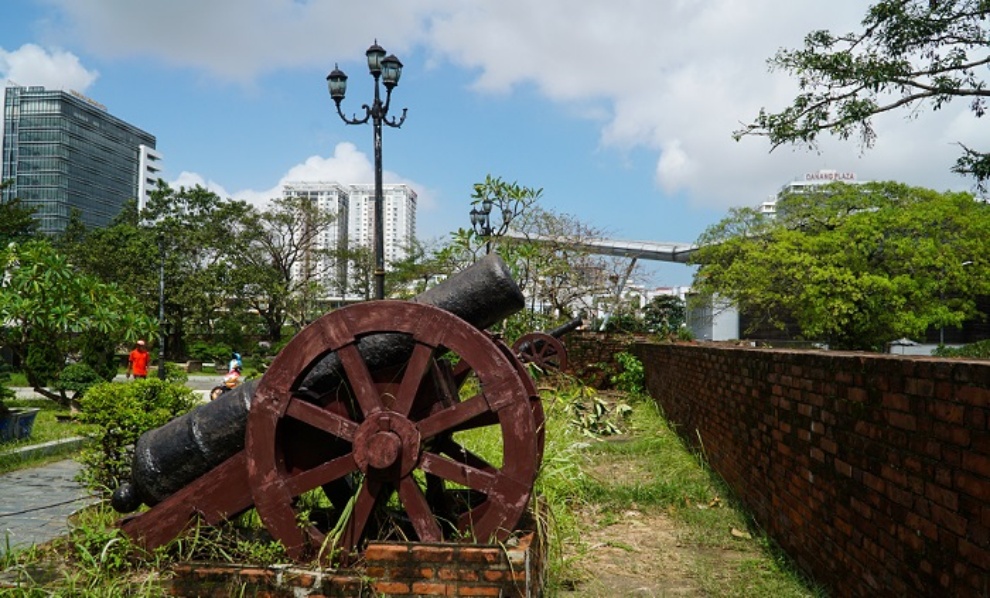Besides Ba Na Hills, My Khe beach with endless white sands or majestic Son Tra peninsula, Da Nang also has a historical color imbued with cultural values. That value is clearly shown through the architecture of Dien Hai Citadel Relics in Da Nang – where hundreds of years old cannons are kept with great historical value. Join Danang Private Car’s to discover a new place in this livable land!
Where is Hai Dien Citadel Relics in Da Nang? Guide
Dien Hai Citadel Relics is one of the famous tourist attractions in Da Nang. The relic is a place to remember the tradition of fighting in the cause of maintaining national independence and defending the territory of the people of Da Nang in particular and the people of the country in general. Currently, the relic of Dien Hai Da Nang citadel is under the management of Danang Museum.
- Address: 24 Tran Phu Street, Thach Thang Ward, Hai Chau District, Da Nang City.
- Hours of operation: 7:30 – 16:30 daily
- Ticket price: 20,000 VND/person
- Free fare: Elderly, children, students, disabled people and permanent citizens in Da Nang city and Quang Nam province.
- Directions: From My Khe beach, tourists follow Pham Van Dong street. Cross the Han River Bridge and then turn right to Tran Phu Street.
Danang Car Rental With Driver – one of the best service of Danang Private Car. Our service with high quality because of not only strongest Basic English speaking driver, friendly, but also cars have free Wi-fi. You also do not need deposit, our driver will collect your money when you arrival in your hotel.

The history of Dien Hai citadel Relics in Da Nang
Dien Hai Citadel, an important historical relic of Da Nang city, was an outpost against the French colonialists from the very beginning when they set foot in our country located on the left bank of the Han River. The citadel was built by King Gia Long in 1813 with the main material being soil with the name Bao Dien Hai. However, because the citadel is located near the sea, it is easily damaged.

In 1823, King Minh Mang ordered to leave the citadel and go to the inner palace and rebuild it with bricks. In 1835, King Minh Mang changed the name to Dien Hai and is used until today.

Today, although Dien Hai citadel is not intact, the south gate of the citadel is no longer, the north is damaged a lot, only the east and west gates still retain the old citadel architecture. With great historical and architectural value, on November 16, 1998, the citadel was ranked as a national historical relic by the Ministry of Culture and Information and was affixed with a relic stele on August 25, 1998.

What’s special about Dien Hai Citadel’s architecture?
Dien Hai citadel became a defensive outpost, preventing the enemy’s footsteps, making an important contribution to the battle to defeat the French colonialists in Da Nang from 1858 to 1860. So today, after centuries, Dien citadel Hai left what?
Ancient Fortress

Dien Hai Citadel Relics was built according to the European design Vauban. Vauban architectural style is built in the style of fortresses for defense created by architect Vauban. The height of the wall is more than 5m, the circumference is more than 556m and is surrounded by 3m deep trenches. The main gate of the citadel is on the south side and the side gate is on the east side.
Inside the citadel, there are works such as flags, warehouses for gunpowder, ammunition, food, and bows, especially can hold 30 large cannons. Dien Hai Citadel was built based on extremely careful and scientific measurements and calculations of the Nguyen kings.
Historical cannons

In addition to admiring the architectural beauty, visitors can also admire hundreds of years old cannons. Including a cannon discovered in 2008 with a length of 2.8m, the diameter of the head is 23cm and the tail is 42cm. Cannons made of bronze, cast iron or iron can weigh up to 3 tons.

Tourist places near Dien Hai Citadel should visit
Visit Dien Hai Citadel Relics, conveniently visit the beautiful old architectures right around the Citadel. Settling down, looking at the frozen flow of time to return to the years of resounding victories of the Vietnamese army and people.
Nguyen Van Troi Bridge Da Nang
Nguyen Van Troi Bridge was built in 1960 connecting the two banks of the Han River with a unique arch design, combining impressive yellow colors. Therefore, this place gradually becomes a virtual check-in place for many tourists when coming to the beautiful coastal city.

Da Nang Cathedral

The church was built in 1923. The unique feature of the church is the shortest construction period in the French colonial period. Classic Gothic architecture, wearing a light pink color. One of the architectural works visitors should not miss when coming to the “City worth living”.
Tam Bao Pagoda Da Nang

The pagoda was built in 1953, completed in 1963. Tam Bao Pagoda has 5 towers of 5 different colors: yellow, red, orange, white, blue. The colors of the Buddha flag. Sitting in the pagoda still retains the new and intact architectural colors.
See More: Da Nang To Hoi An Private Car
Listen to the stories behind the architecture of the Hai Dien Citadel in Da Nang and discover the unique features of the majestic, ancient and solid military citadel despite many years of experience. Come to Da Nang, don’t forget to visit and check-in to save memorable memories here!

